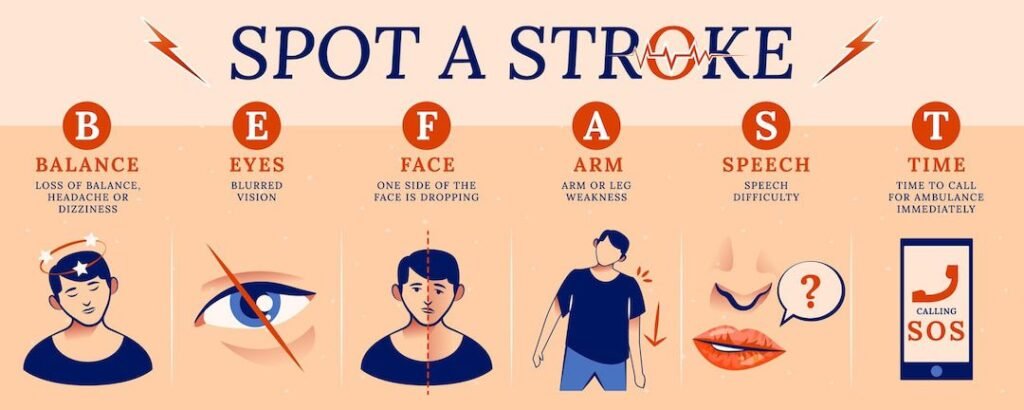Stroke is a devastating medical emergency that affects millions of people worldwide. It is one the leading cause of death and long-term disability of individuals. Fortunately, the brain damage can be reduced if the right steps are taken early on. To help with this, it is crucial to know the symptoms of stroke, the warning signs, when it is important to seek medical attention, and the prevention strategy to minimize the complications.

To make you understand better about stroke we will discuss the leading cause of stroke and the changes in lifestyle which can prevent stroke.
Leading Causes of Stroke
One of the best ways to prevent stroke is awareness. You should first understand the major risk factors of stroke so that you can take action immediately if you experience any of them. By managing the risk factors early on you can reduce the chances of having stroke. To manage the risk factors, you should know the leading causes of stroke.
While some of the risk factors are beyond our control but some of them are influenced by our lifestyle choices. If you are experiencing any of the risk factors mentioned below, then you need to communicate with your medical advisor about the same.
1.High Blood Pressure (Hypertension)
Hypertension is one of the leading causes of stroke because it weakens the blood vessels and increases the risk of blood clots which can lead to ischemic stroke..
Additionally, high blood pressure increases the risk of vessel rupture as it places extra strain on the wall of arteries, which can cause hemorrhagic stroke.
Maintaining a healthy blood pressure through lifestyle changes such as a balanced diet(low sodium), regular exercise, stress management techniques, and limiting alcohol consumption can help in preventing stroke.
2. Smoking
Tobacco contains harmful chemicals that damage the blood vessels, promote plaque buildup, and increase the risk of blood clots in arteries. Each of these factors contribute to increase the risk of stroke.
So, it is important to quit smoking to prevent stroke or any another health issues and live a healthy life.
3. Diabetes
1 in 5 people who have a stroke are diabetic and the risk of stroke is more in people with diabetes than people who are not diabetic.
Diabetes contributes to hardening of the arteries(atherosclerosis), which increases the risk of blood clot or a ruptured blood vessel. People with diabetes are also likely to experience a number of additional stroke risk factors including obesity, poor diet, inactivity, high cholesterol.
Maintaining low sugar diets and doing regular exercise is important for managing the sugar level.
4. Obesity and Physical Inactivity
Obesity is also a major factor for stroke.
Being obese or overweight and leading a sedentary lifestyle can cause other health issue like diabetes, high cholesterol, and hypertension and all of these are major risk factors for stroke.
5. High Cholesterol
High levels of cholesterol is a significant risk factor of stroke because it contributes to the development of atherosclerosis, a condition characterized by the buildup of plaque in arteries. When cholesterol level is elevated Particularly LDL cholesterol, it can lead to accumulation of plaque on the walls of blood vessels, including those supplying blood to the brain.
There are two Types of cholesterol LDL (low-density lipoprotein) and HDL (high-density lipoprotein).
LDL is considered as bad cholesterol because it contributes to plaque buildup in arteries, making the arteries narrower and increase the risk of clotting which can cause stroke whereas HDL is considered as good cholesterol because it helps in preventing stroke by carrying LDL cholesterol away from the arteries, back to the liver.
Focusing on limiting your consumption of LDL and increasing your intake of foods with HDL can help in preventing stroke.
Management tips for leading causes of stroke through lifestyle changes

Mostly, stroke can be prevented by making some preexisting lifestyles change and adapting to a healthy lifestyle.
Here are the changes which can help maintaining a healthy lifestyle:
- Maintain a healthy blood pressure level by taking low sodium diet
- Quit smoking to avoid tobacco consumption
- Focus to maintain a healthy low cholesterol diet
- Eat food like Fish, nuts, etc. to increase consumption of good cholesterol
- Limit alcohol consumption
- Take your medications as prescribed for maintaining low blood pressure or diabetes.
- Check blood pressure regularly to avaoid any further health issues
- Improve physical activities and do regular exercise
- Change your sleeping habits, try to take a good 6-8 hours sleep.
Furthermore, adapting to a healthy lifestyle can help in preventing stroke but it is also important to take medical attention and talk to your doctor about medications time to time to avoid any health-related concerns.
-By
Dr. Virendra Vikram Singh(PT)

